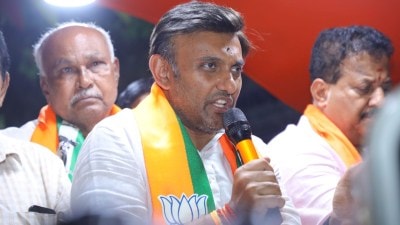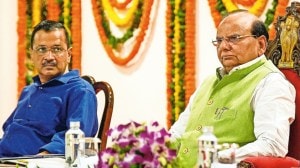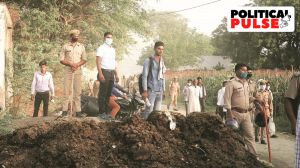- India
- International
A new documentary examines how ‘viral videos’ spread hate against minorities
What documentary filmmakers Shirley Abraham and Amit Madheshiya found while making a short film on the online and offline ecosystem of lynchings.
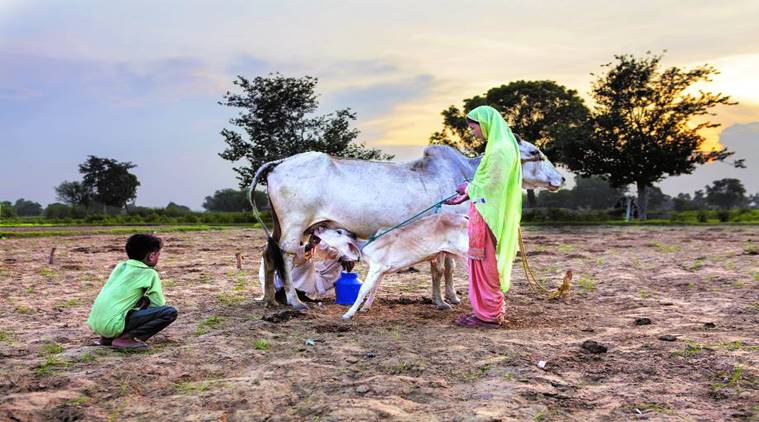 Asmeena, the wife of Rakbar Khan, who was beaten to death on the suspicion of cow smuggling, tends to a cow. (Photos: Amit Madheshiya)
Asmeena, the wife of Rakbar Khan, who was beaten to death on the suspicion of cow smuggling, tends to a cow. (Photos: Amit Madheshiya)
Their first film, on the now-obscure travelling cinemas of Maharashtra, debuted as an official selection at Cannes in 2017 and won awards at several major festivals. In the years since, documentary filmmaker duo Shirley Abraham and Amit Madheshiya have trained their focus on the fault lines of contemporary India. Their short documentary, Searching for Saraswati, released via The New York Times last year, explored how ancient myths are being used to push the idea of hypernationalism. Their latest project, titled The Hour of Lynching (18 minutes long), looks at how “viral videos” are being used to perpetuate hate towards minorities. It is the first documentary from India to receive a Pulitzer grant, and will be released in the US and in the UK (through The Guardian) later this month. In this interview, they talk about the power of imagery, the idea of justice and the ecosystem of lynchings. Excerpts:
Why do you think there is an international interest in the lynchings in India?
Shirley Abraham (SA): I’d say it’s the continuity of history. The American South has had a traumatic history, where 4,400 such documented incidents took place between 1877 and 1950.
Amit Madheshiya (AM): This sort of primordial violence happening in contemporary India is the first degree of shock for anyone. Around 49 people have been lynched to death since 2014, yet it’s not an election issue. Today, the US has a museum of lynchings where they memorialise those incidents, acknowledging that they, as a people, came to a point where they thought it was okay to carry out such gruesome violence. But here what we have is silence.
In the US, the memorialising came 70 years later. Do you think India needs time to reflect as well?

AM: The template exists in the form of American racial history. We have to learn not to do this again. That is why history exists, so that we can learn.
Did you decide to document the lynchings because of the silence?
AM: Mob lynchings are a kind of spectacle that asks for an audience. A theatre that happens in public. The ones participating in it believe they have to send out a message — both to the minority and the majority. To the former, they say, ‘You are unwelcome here and there is no rule of law to protect.’ To the majority, ‘This is what we can do.’ This idea is encouraged when we do not condemn it and choose to remain silent.
Since I am a photographer, I go back to Roland Barthes’s landmark essay (The Photographic Message), where he says a photograph does transmit a code that this event happened in a specific moment at a specific time. But moving images, which we gruesomely refer to as viral videos, convey the message that the same incident can be made to happen again. They are meant to goad the majority. In this theatre, one doesn’t applaud by clapping but by keeping quiet. We, as documentary filmmakers, had to break the fourth wall and condemn the act.
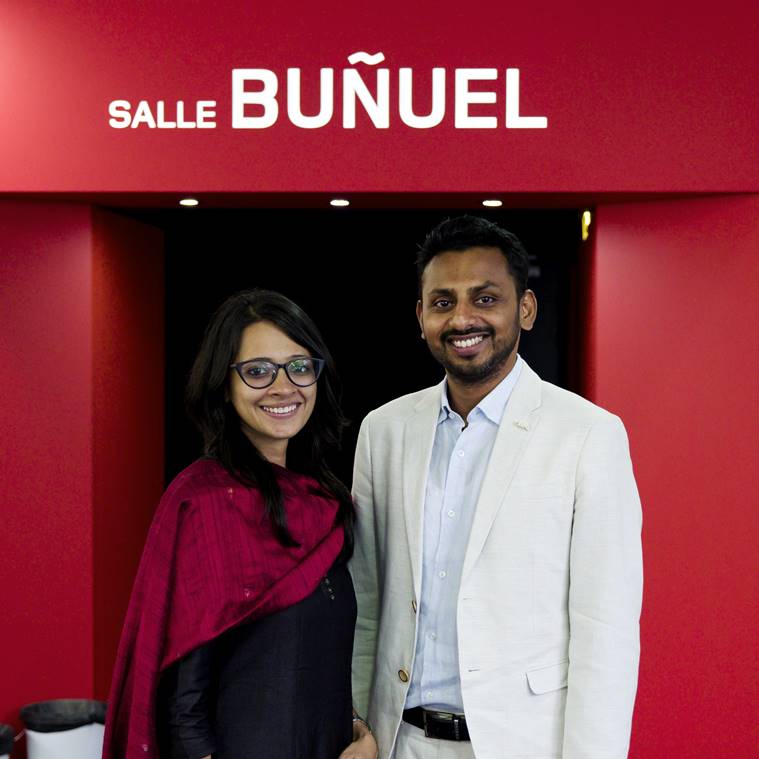 Shirley Abraham and Amit Madheshiya (Photos: Amit Madheshiya)
Shirley Abraham and Amit Madheshiya (Photos: Amit Madheshiya)
Is that why you chose the medium of the moving image?
AM: Our film is a critique and comment on the lynchings. In the American South, professional photographers were invited to take pictures of white men along with their victims hung from trees or set to fire. The photographs were souvenirs for rich white men. Today, people perpetrating the violence in India are taking their own images. It comes with a great sense of impunity that nothing will happen to us. They believe they have to create this spectacle for it to be recreated elsewhere. The film is also a critique of how we all own these videos today and, in the process, become complicit to the crime.
SA: I was interested in the idea of justice. The mobs believe they are above the law. In this way, they find a sense of justice for themselves. But when we met the families of the victims, we realised they, too, were seeking videos of their loved ones as a way to validate their grief or accept that such an incident happened. Asmeena, the wife one of the victims Rakbar Khan, who was lynched in July 2018 in Alwar, says she wished everybody could see the perpetrators the way they were consuming her pictures on news media. She came to a point of acceptance that even if the perpetrators continue to live with impunity, there will be some form of justice if they do not remain faceless.
Why did you choose the short documentary medium to tell a story with so many facets?
AM: The perpetuation of this spectacle happens online through WhatsApp groups and social media. It is the ecosystem the virus is infesting, so we wanted to inject an antibody within the same system. The internet is the best medium for a film on viral videos.
If the lynchings are a part of a larger ecosystem that directs hate at the minorities, why did you focus only on the killings?
SA: We found the lynchings a good way of looking at our moral compass. Take, for instance, the case of Mohammad Akhlaq. The narrative after his lynching was skewed. When the system spoke about a slaughter, it was the slaughter of the imagined cow, and not the man. It was the food in his fridge that was sent for forensic testing. When talking of the accused, people spoke of the man who was lynched and not the people who committed the gruesome act. There was a complete inversion of what we know as right and wrong.
It’s a crime, yes, but what happens when such orgiastic violence is injected into the bloodstream of a society? One thing is we develop a very high level of tolerance for violence.
AM: It’s also why we chose to work with one family (Rakbar Khan’s). The grief is lost in statistics. While important, they don’t illuminate the human experience. How is the family coping? Has it disintegrated? These were some of the questions we wanted to explore.
SA: I believe we were able to evoke an essence of that larger ecosystem through this film. We see children as young as 10, being given weapons training, which means they are being trained by a militaristic society.
How much did you find the government to be responsible?
SA: The Prime Minister spoke up only once after the first reported instance of lynchings. His, and his ministers’ silence, is an enabler in such a case. In an essay, James Baldwin says mobs are not autonomous…they execute the real will of the state even though they are faceless. There are FIRs being filed against “unknown persons”. Who are these? Who is outsourcing this to the mobs with impunity? That is something that remains known and hidden at the same time.
AM: Many perpetrators have been rewarded publicly. For instance, BJP Union minister Jayant Sinha garlanded an accused in Jharkhand.
This article appeared in print with the headline ‘The Ones Who Got Away’
Apr 27: Latest News
- 01
- 02
- 03
- 04
- 05











